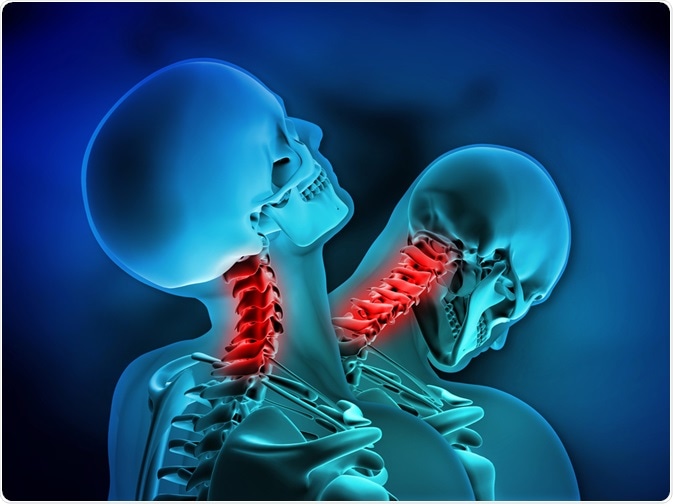Whiplash and whiplash-associated disorders (WADs) refer to various injuries of the neck that occur as a result of sudden extension and flexion from unexpected head movements. In most cases, WADs are not usually life-threatening; however, WADs can impact the quality of life of affected individuals on a long-term basis significantly.
Whiplash and WADs are strongly associated with road accidents; particularly rear-end collisions. As a result, some vehicle manufacturers have researched the biomechanics of common road accidents and have since developed seats with enhanced protection against WAD.
 Image Credit: BioMedical / Shutterstock.com
Image Credit: BioMedical / Shutterstock.com
Causes of whiplash
Physiologically vigorous movements of the head that cause damage to the ligaments and tendons in the neck are responsible for the symptoms of whiplash. These ligaments, which are commonly stretched or torn, typically recover to full strength over time; however, in some cases, the ligments will never fully recover.
There are various causes of WAD, including road accidents, contact sports, and falls that involve head injuries. Of these, automobile accidents are the most common cause, which explains why whiplash is commonly associated with road accidents. Although sudden movements of the head in any direction may cause whiplash, read end crashes most commonly result in WADs.
Head restraints
Initial methods to protect the neck and prevent cases of whiplash focused on car seat design, particularly with the introduction of head rests that are designed to restrain the head in dangerous situations.
However, this approach assumes that mechanical factors are the direct cause of WAD and do not consider other related areas of the body, such as the spine. Current research suggests that head restraints offer a small reduction in the incidence of whiplash by about 5-10%.
WHIPS
Volvo undertook the most comprehensive study that examined the effects of specific protection systems on whiplash and WADs. This study focused primarily on rear-end car impacts and involved the use of their protective systems to avoid or lessen the severity of whiplash.
The research extended over a period of more than ten years and studied the causes of neck injuries and possible protective systems in great detail. It included comprehensive data about road accidents and research about how these accidents occurred, which led to the development of seats with superior protection against WAD.
The biomechanical injury mechanisms that tend to lead to whiplash were interpreted and explained at the end of this study. This then led to the design of a whiplash protection seat, which was tested using the rear end impact dummy BioRID.
This study concluded and demonstrated that, with adequate accident and biomechanical research, a seat can be designed to help protect the neck and spine from low to moderate impacts.
Efficacy of protection mechanisms
As whiplash injuries can present with significant symptoms that may continue for varying lengths of time, the development of mechanisms to offer protection from WAD is an important step. The seats offering high protection appear to reduce the risk by more than 50%, although it is difficult to estimate real-life results, as not all consumers opt for seats with these safety features.
In addition to general safety protection principles, it is important to consider individuals that may occupy the seat and their various heights, positions, and postures . The WHIPS-seat can help to provide considerable protection, but may need to be redesigned slightly for specific occupants.
Although steps are being made in the right direction to improve road vehicle safety and reduce the risk of WADs, further developments can still be made to improve safety technology in the future.
References
Further Reading